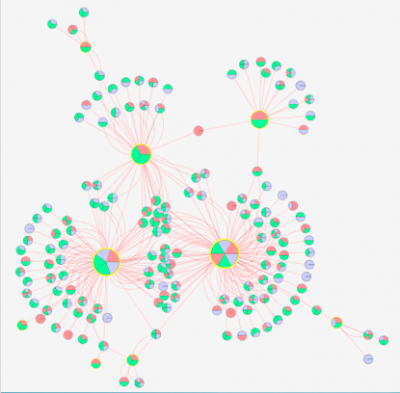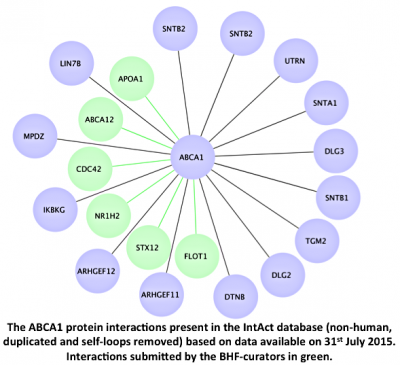
- Example of curated protein interaction: GSK3B-APC-Beta catenin
We, therefore, manually captured protein-protein interaction (PPI) experimental data from the cardiovascular-related literature and submitted this to the IntAct public dataset at EBI, with the source 'bhf-ucl'. This data was then incorporated into the IMEx Consortium dataset.
Our initial approach was to identify PPI data we had previously submitted to the GO annotation file and re-annotate these experiments to IMEx standards and submit to the IntAct dataset. The GO PPI data had been created as part of the 2007-2012 BHF funded Cardiovascular GO annotation Initiative. For example, the interaction between DVL1 and DVL3 described by Kishida et al, 1999, was captured as a GO annotation in 2008. The DVL1-DVL3 interaction data is now in the IntAct and consequently in the IMEx datasets and is therefore readily accessible for inclusion into interactome networks created using appropriate software such as Cytoscape.
However, as 95% of the experiments re-annotated met IMEx standards, we realised that a more efficient use of our time and resources would be to provide a file containing all GO PPI data for use in network analyses. Consequently, Tony Sawford, at EBI, created the EBI-GOA-nonIntAct dataset, which contains all PPIs already deposited in GO and is accessible via the PSICQUIC server. Here, the data is available freely for download and manipulation, for example via the Cytoscape software.
This file provides a much broader coverage of proteins than we would have been able to achieve and also provides PPI data for all species manually annotated by the GO Consortium.
Specific annotation projects:
- Dark Space Project (DSP) in collaboration with Pablo Porras Millan at IntAct Database (Nancy)
- Lipid traits (Nancy, Mila)
- Cardiac electrophysiology (Ruth)
- Telomeres (Nancy)
- Wnt signalling (Anna)
- Heart development (Mila)
Annotation progress can be viewed either using the search phrase 'annot:"dataset:cardiac"' in the IntAct browser search field or using the advanced fields search option and selecting from 2 drop down menus field: dataset, cardiac. These approaches both retrieve a list of interactions, which can either be downloaded or viewed using the graph tab.

Our additional PPIs have improved the networks available for individual proteins, for example the number of proteins annotated as associated with ABCA1 has increased from 14 to 20 interactions (including duplicated and self-interactions).
 Close
Close

